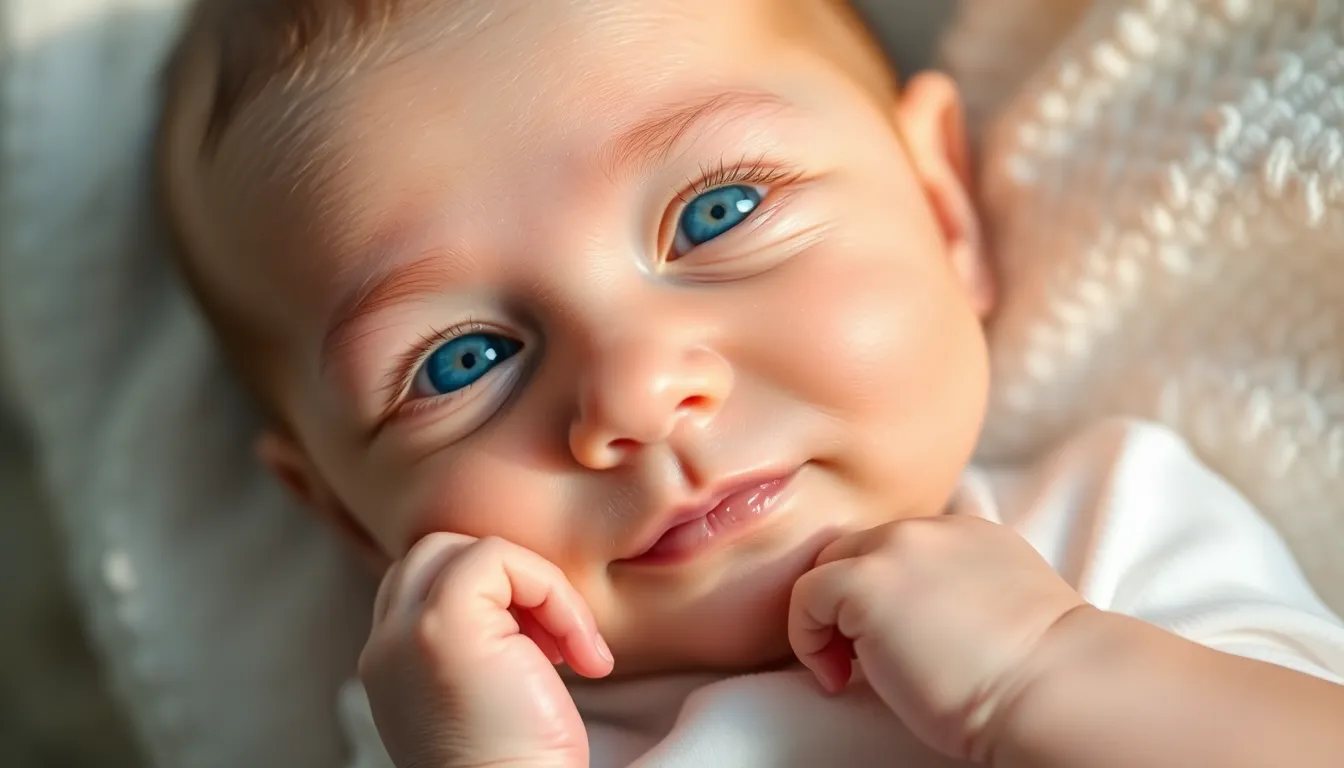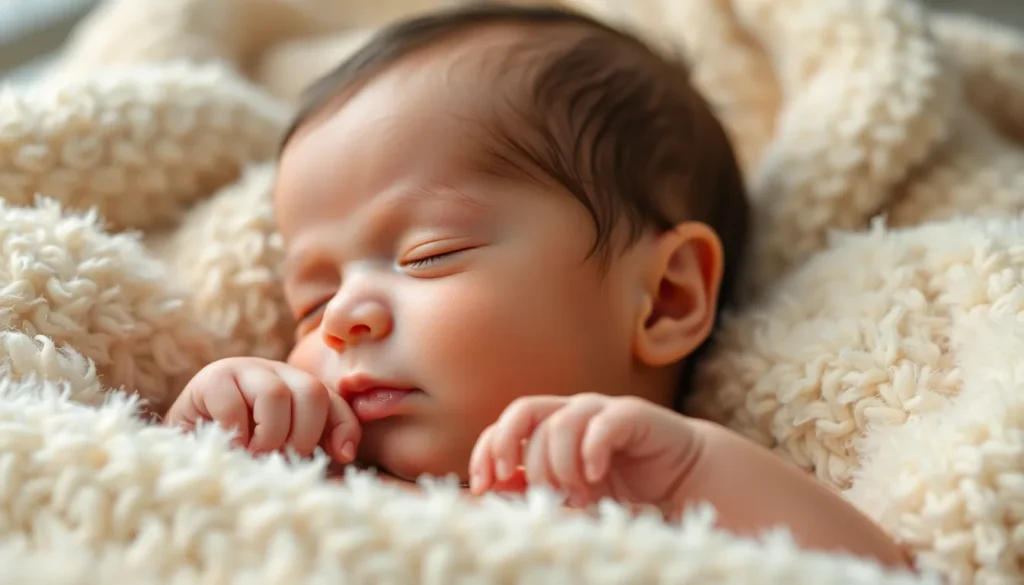Ever stared into a newborn’s eyes and wondered if those peepers would stay blue or turn brown? You’re not alone. Many parents find themselves captivated by the mystery of their little one’s eye color. It’s like waiting for a surprise party to unfold, but instead of balloons, you get a kaleidoscope of hues that may or may not stick around.
Table of Contents
ToggleUnderstanding Infant Eye Color
Infant eye color is primarily determined by genetics. Most newborns start with blue or gray eyes due to low melanin levels. Eye color changes often occur within the first year, typically peaking around six months. Parents observe these changes as melanin production increases in response to light exposure.
The most common eye colors are brown, blue, and green. Brown eyes are dominant, meaning if one parent has brown eyes, their child is more likely to inherit that color. Variations in eye color result from multiple genes interacting, making predictions challenging.
If both parents have blue eyes, it’s likely their child will, too. However, surprises can happen because of hidden genes. Genetic contribution from distant relatives can influence eye color outcomes.
Factors contributing to changes in eye color include age and sunlight exposure. Babies often display lighter hues before their true eye color emerges. Darker shades develop later as melanin accumulates. By age three, most children have permanent eye colors.
It’s common for parents to track these changes closely. Frequent photo documentation helps capture moments as eye color evolves. This attention reflects their fascination with the developmental process.
Understanding the timing and reasons for these changes can ease parental anticipation. Awareness of genetic traits enhances knowledge about potential outcomes, allowing families to embrace the transformation. Rather than worry, parents can celebrate the journey their baby’s eye color undertakes.
Factors Influencing Eye Color Change

Several factors influence the changes in a newborn’s eye color. Understanding these elements helps parents anticipate their child’s eye color journey.
Genetics and Heredity
Genetics play a major role in determining eye color. Parents pass down specific genes that can express dominant or recessive traits. Brown eyes appear most frequently due to a dominant gene, while blue and green eyes are typically linked to recessive genes. Children with blue-eyed parents often inherit blue eyes, but hidden genes from ancestors can surprise parents with unexpected colors. Genetic variation means that even within the same family, eye colors can differ significantly among siblings. Family histories reveal fascinating patterns that align with genetics, emphasizing its importance in eye color determination.
Melanin Production
Melanin production significantly affects eye color during the first year of life. Low melanin levels in newborns give them lighter eyes, typically ranging from blue to gray. Exposure to light influences melanin secretion, causing darker hues to develop as babies grow. Peak melanin production occurs around six months, which often leads to noticeable color changes. Parents may notice their infant’s eyes gradually shifting to a more permanent color influenced by their genetic makeup. By age three, most children settle into their lifelong eye color, reflecting the culmination of melanin levels and genetic factors.
Typical Timeline for Eye Color Change
Newborns often start life with blue or gray eyes due to low levels of melanin. Changes in eye color typically begin during the newborn stage as their bodies start producing melanin. By three months, some infants may already display noticeable shifts, but the final color isn’t established yet.
Newborn Stage
During the newborn stage, eyes often appear lighter, reflecting low melanin production. Genetics plays a crucial role at this time, with many babies born with blue or gray eyes. Parents might notice slight darkening or other variations as weeks go by, providing hints at the eventual change.
Around Six Months
By around six months, significant changes frequently occur. Melanin production ramps up, influenced by light exposure, leading to gradually darker eyes. This period often reveals a clearer indication of the child’s future eye color, with many transitioning to shades of brown, hazel, or green. Genetic factors remain instrumental, as recessive traits can also manifest.
One Year and Beyond
One year marks a pivotal moment in eye color development. Most children have settled into their permanent colors by this age, showing clarity and vibrancy. The majority will reflect the results of genetic combinations and melanin levels developed through their first year. Changes might still occur after this period, but they become less common as children approach three years old.
Common Eye Colors in Newborns
Newborns often exhibit a range of eye colors at birth, primarily due to low melanin levels. Typically, the initial eye colors observed include blue, gray, or even green. Most commonly, blue eyes appear, which relate to lower melanin presence. Brown eyes tend to dominate, stemming from genetics and the more abundant melanin production.
Blue-eyed infants frequently belong to parents with lighter eye colors, yet hidden genetic traits may surprise them. Brown-eyed parents might have children with blue or green eyes due to recessive genes. Another noteworthy observation involves hazel eyes, which can develop later as melanin increases and light exposure influences pigment production.
Three months into life, noticeable shifts in eye color may present themselves. A child born with blue eyes might begin showing hints of darker shades. Experts note that around six months, the influence of melanin becomes more pronounced. By this age, visible changes are common, reflecting potential permanent eye colors.
Most children establish their final eye color by the first birthday, although variations can still occur. Children may transition to a richer shade or develop clearer hues, influenced by ongoing melanin production. Tracking these changes can be exciting for parents, as they witness their newborn’s evolving eye color, capturing memories through photographs. Each discovery about eye color can deepen their understanding of genetics and the dynamic nature of this early trait.
The journey of a newborn’s eye color is a captivating experience for parents. From the initial surprise of blue or gray eyes to the gradual changes that unfold within the first year, every shift tells a story of genetic interplay and natural development. As melanin production increases and exposure to light influences these changes, parents eagerly anticipate the final outcome.
By one year, most children will have settled into their permanent eye colors, although surprises can still occur. This transformation not only reflects the beauty of genetics but also offers parents a chance to cherish each moment. Documenting these changes through photos adds to the joy of this unique journey, creating lasting memories of their child’s early development.




